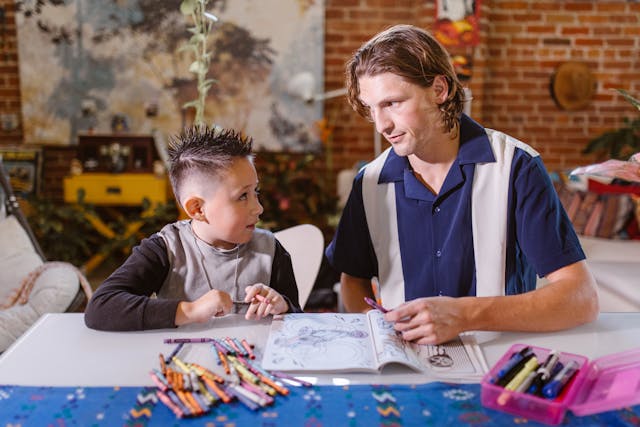
Published: October 2, 2025
By: Jane Mitchell
Starting fresh in a new classroom can bring excitement and anxiety for children. Parents want their kids to feel confident and secure, yet the change often brings uncertainty. Families frequently look for strategies to make transitions smoother and less stressful. This guide explores practical ways to help kids adjust to new schools while also strengthening family bonds at the same time.
Establishing Routines That Bring Comfort
One of the first steps is creating steady routines that give kids a sense of safety. Daily habits bring order to unpredictable days and reduce friction during transitions. Routines that can reduce family stress include consistent bedtimes, clear morning schedules, and planned homework times. When children know what to expect, they feel less nervous about the unknowns waiting in a new environment.
Morning routines can set the tone for the whole day. A calm breakfast together or a few minutes of conversation before leaving the house make children feel grounded. Evening routines, on the other hand, help them release school-related tension. Predictability offers stability when everything else seems new.
Managing Moves With Children
A move can feel overwhelming for kids because it changes more than just schools. Leaving behind close friends, favorite playgrounds, and familiar routines often creates uncertainty. Taking time to explain when the move will happen and what changes to expect helps children feel more prepared. Honest conversations about their worries or excitement remind them that their feelings matter, which makes new classrooms and neighborhoods easier to embrace.
Also, when relocating with children, small steps can reduce stress and even build excitement. Involving them in simple choices, like packing a box of their favorite belongings or helping pick decorations for their new room, gives them a sense of control. Exploring nearby parks, playgrounds, and local stores together also helps them feel connected to their new community. These actions turn the move into an adventure instead of just a disruption, making the transition smoother for the whole family.
Help Kids Adjust to New Schools: The Role of Parental Support
Children notice when parents stay calm and positive. A confident parent sets the tone for how a child views school changes. Small gestures such as walking them to class, meeting teachers, or talking about exciting school events show support. Kids learn that they are not facing this transition alone.
Parents who demonstrate patience also teach children resilience. Instead of rushing to “fix” every struggle, they model calm problem-solving. This approach encourages kids to develop their own coping skills.

Parents set the tone during school changes. Calm support and patience show kids they’re not alone and help them build resilience.
Creating Familiarity in a New Place
A strange school feels less intimidating when kids see something recognizable. Bringing a favorite lunchbox, backpack, or even a family photo helps them settle into new spaces. Parents can also walk through the school together before the first day. Familiar hallways and classrooms reduce anxiety and prepare kids for what’s coming.
Building familiarity outside of school matters too. Exploring the neighborhood, finding local parks, or visiting nearby stores helps children feel that the new environment belongs to them. These experiences ease the sense of being an outsider.
Building Confidence Through Small Wins
Confidence grows when children succeed at manageable tasks. Completing homework, answering a question in class, or joining a group project gives them a sense of belonging. Parents can praise these small victories, reinforcing the idea that effort brings success. Over time, this builds resilience and encourages them to keep trying even when school feels difficult.
Confidence is contagious. When children feel proud of their accomplishments, peers often notice and respond positively. This feedback loop can help kids adjust to new schools and feel included and valued in their new setting.
Supporting the Transition Back to School
Some children experience added stress when the move happens during the middle of the year. Parents must provide extra encouragement to smooth this shift. Special attention to routines, reassurance, and patience makes a big difference. For many families, the back-to-school season becomes a chance to reset and re-establish habits that carry kids through the year.
Joining seasonal school events, such as fall fairs or spring concerts, helps children feel included quickly. These activities introduce them to traditions that make a new school feel familiar.
Working With Teachers
Teachers are partners in the adjustment process. Meeting them early helps parents share insights about their child’s personality, strengths, and worries. Teachers often have strategies for easing transitions, such as pairing new students with buddies. Building a good relationship with the school staff shows children that everyone is working together for their benefit.
This cooperation also prevents misunderstandings. When teachers understand a child’s background, they can respond more compassionately if challenges arise.
Helping Children Choose the Right Activities
Extracurricular activities create a sense of identity. They also help kids discover friendships outside the classroom. Parents should guide children in choosing after-school activities that match their interests and comfort level. A child who enjoys art may thrive in a drawing club, while another who loves movement may prefer sports. The right choice gives them a reason to look forward to school days.
Exploring different activities also teaches flexibility. If one option doesn’t work out, children can try another until they find something they enjoy.
Teaching Coping Strategies
Stress is normal during transitions. Parents can teach children simple ways to calm themselves, such as deep breathing or taking short breaks. Encouraging them to write in a journal or draw their feelings can also help. These tools give kids independence in managing worries when parents are not nearby.
As they grow older, these coping strategies become lifelong skills. Kids who learn them early can face challenges with greater resilience.
Encouraging Independence
Independence builds confidence. Allowing children to pack their school bag, plan their outfit, or handle small responsibilities gives them control over their day. These tasks also teach problem-solving skills. When children see themselves as capable, they carry this self-belief into the classroom.
Balancing independence with guidance is key. Parents should step in when necessary, but let children try new responsibilities on their own whenever possible.

Letting kids take on small tasks fosters confidence. Packing their bag or planning outfits teaches responsibility while building independence.
Staying Patient as a Parent
Parents may feel frustrated if the adjustment takes longer than expected. It’s important to remember that transitions are a process. By showing patience and staying consistent, parents give children the security they need. Calm guidance lays the foundation for long-term success in school and beyond.
Parental patience creates a ripple effect. Children model this calm behavior in their own challenges, learning valuable lessons about perseverance.
Helping Kids Thrive in New Schools
Supporting children through school transitions requires steady routines, open communication, and patient encouragement. Families who focus on small victories, friendships, and positive reinforcement see their children adapt with more confidence. Every child deserves a chance to feel secure and successful in a new classroom. With practical strategies, parents can truly help kids adjust to new schools and ensure they thrive in every new environment they face.
